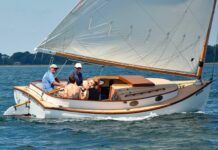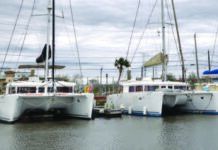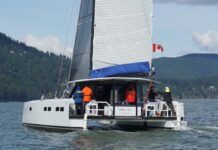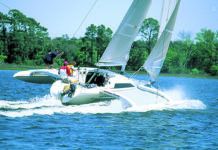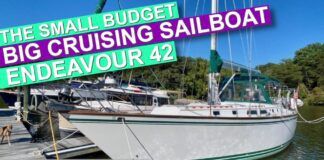On monohulls, the greatest stresses and some of the most serious failure involve the keel, rudder, and chainplates. We inspect the keel bolts and the bilge around them with a close eye; any crack is very serious. We look for cracks on the outside, where seawater might seep in and rust any bolts. The same goes for the rudder tube and the blade. Bulging here could mean water has entered and expanded into ice, or that corrosion is hiding beneath the fiberglass. A monohull rig has a relatively narrow base, so shroud loads are high. Chainplates are often buried behind joinery or glasswork, making them difficult to inspect.
Multihulls, have different vulnerabilities and inspection points. There are no keel bolts, rudder loads are lower, and rigging loads are applied across a broad footing. But beams and bulkheads are twisted in a repeated, jerking motion, rather than pressed inwards, as on a monohull. Keeping the weight down is important on multihulls, so there is a tendency to push the envelope on strength-to-weight ratios. Finally, many boats are sold on the basis of how pretty the cabin is at dock, not how functional it is in a storm.
Gelcoat cracks. Most older boats have a few hairline cracks, the result of flexing and mold shrinkage. This is aggravated wherever the gel coat was laid too thickly in the mold. You’ll see these at the corners of steps and edges of cabins. They’re not always serious, but since multihulls are more likely to use the deck, hull liners, and interlocking molded sections as crucial structural elements, they should all be investigated.
Core. Multihulls are cored to save weight, and most components provide structural support. Assume that any soft area is urgently in need of repair, and assume that all fittings should be rebedded on any boat over 10 years old. Ideally, the hull is NOT cored below the waterline, but most are.
Centerboards and daggerboards. The loads on the centers are enormous and they can be subject to breaking loads in the event of a grounding. Closely inspect where the centerboard case meets the hull and the bracing around the case. Jamming can be a problem, so check for easy movement at rest (not while sailing). Small fixed keels are less vulnerable, and any damage is usually easy to repair. They are not ballasted, so there are no critical keel bolts. The keels are often a structure that is molded separately and then bonded and fiberglass-taped to the hull.
Interior. Unlike a monohull, the hulls will twist. If you build a plywood interior module and then roughly bond it in place (as is often the practice), it may not stay put. The different sections will move differently, resulting in misalignment. Molded interiors give a clean look and can contribute to stiffness, but they also hide a lot. Stringer and bulkheads should be either fiberglass or high quality marine ply, and should be carefully bonded with substantial fillets and preferably fiberglass tabbed or taped in place.
Cracks in the lining resulting from twisting range from cosmetic to structural, and may indicate structural problems underneath.
Beams. These are often built from sections that are glued together and can be prone to delaminating and failure. They are repairable, but inspect closely. In the event of failure, the repair cost will depend on the location. Repairing beam ends can be very expensive.
Escape Hatches. Safety standards require that hatches be installed to provide escape from an inverted multihull. At boat shows, salespersons often describe how cool it is to watch the water go by. But these hatches can fail. Marita, a 2018 Helia catamaran made by Fountaine Pajot, was reportedly lost when the sea pulled the glazing in a Goiot hatch out of its frame. Confirm that the hatches have been upgraded and that they are in pristine condition. Some cat sailors regard escape hatches as a mistake; regarding the risk of failure outweighs the potential benefit in the rare event of a capsize.
Rigging. Although the rigging load paths follow less acute angles on a catamaran, the loads and fatigue problems are similar to those on monohulls. However, mutihulls are stiff under sail, so the gust loads are not relieved by heeling. The motion is sharper, causing the rig to snap from side to side in a cross sea. Because the rigging loads are supported by beams instead of the keel, pretension is less, which can lead to slack leeward shrouds and snatching in rough seas. In fact, the rigging will generally be slightly heavier than that for a similar height mast on a monohull. On the other hand, chain plates are often external and thus much easier to inspect for corrosion.
Sails. The multihull’s wide rigging base would prevent an overlapping jib from being sheeted-in tightly. As a result, the working jib on a multihull is smaller than on a monohull. A fully-battened mainsail delivers most of the horsepower while reaching. Off the wind, large downwind head sails are easily managed from a broad foredeck. High roach mainsails need to be carefully constructed to avoid problems with wear and jamming in the track. They can constantly rub on the rigging while sailing off the wind. Large chafe patches on the batten pockets typically solve the problem. Full battens make dropping the sail with lazy jacks a breeze.
1. This folding trimaran broke both of its cross-beams, after one failed due to faulty bonding between the outer laminate and the core. When the first beam broke, the second became overloaded, twisted, and failed.

2. Small hairline cracks in the deck can often be fixed with fairing and filling. These cracks, located at boltholes for a winch, formed because the laminate was too thin and there was no backing plate.

3. This liner crack resulted from a poorly reinforced centerboard trunk.

4. This gelcoat crack on deck flagged a weakness in the lamination beneath the hull that needed to reinforced with more laminate. Loads often concentrate in corners where the load paths changes direction.

5. The top flange of this centerboard case was not built to designer specification and failed.




